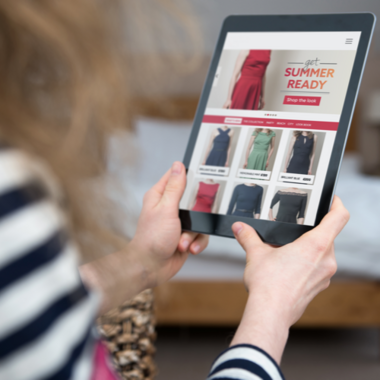
- Five minutes read
How COVID-19 has permanently changed payment habits
The online payments landscape is continuing to diversify, and COVID-19 has been an accelerant. Consumers have changed the way they pay online during COVID-19, and plan to make these changes permanent. In many cases, consumers now have a new preferred payment method.
Lost in Transaction: Consumer payment trends 2021 was written using independent data commissioned by Paysafe and conducted by Sapio Research. The full results of this research are available to download here.
Is COVID-19 changing the way people pay online?
Overall, card payments continue to be the most popular payment methods online, with more than half of all consumers having used a debit (54%) or credit (51%) card to complete a transaction in the past month. Debit cards are particularly popular in the UK (71%) and Bulgaria (75%), while credit cards are more popular in Canada (72%).
Paying via a digital wallet (43%) is clearly the most popular alternative payment method to credit and debit card payments, especially in Europe. In Italy more consumers have used a digital wallet to make an online payment in the past month than a credit or debit card.
Direct bank transfer, pay by invoice, and eCash all continue to be popular payment methods in Germany and Austria, and cryptocurrencies continue to grow in popularity, with 9% of consumers saying that they have used crypto to make a payment in the past month.
Q: Which of the following payment methods have you used in the past month when making payments online?
When we asked consumers how their spending habits had changed during COVID-19, only 14% said that they hadn’t changed their payments habits at all. Of the significant majority (86%) of consumers than confirmed their spending behaviour had changed, there was no overwhelming preference for any particular payment method. Again debit (40%) and credit (36%) cards are the most popular, followed even more closely by digital wallets.
One outlier of note is the significant uptake of prepaid cards in Italy. 39% of Italian consumers said that they are using prepaid cards more frequently now than before COVID-19, putting this payment method only behind digital wallets (45%) in terms of popularity growth.
Q: Which of the following online payment methods are you using more frequently (a greater percentage of your transactions) now than before COVID-19?
In addition to using payment methods they were already familiar with during COVID-19, many consumers (59%) have also experienced using a new payment method for the first time in the same period. And younger consumers are much more likely to have tried a new payment method during this time; over three quarters (77%) of consumers aged 18-24 have used a new method to pay since the beginning of the pandemic, compared to only 27% of consumers aged 65 or over. The percentage of consumers that have used a new payment method for the first time during the pandemic decreases with every age bracket.
And there is not only a difference in propensity to use new payment methods, there is also a distinction between payment methods that different age demographics have used. Where older consumers have used new payment methods, this is most likely to be debit card payments. For example, 45% of consumers aged 65 or over that had tried a new payment method during the pandemic used a debit card, compared to just 35% of consumers aged 18-24 and 35% of consumers aged 25-34.
In contrast, in every age group under 45-54 digital wallets was the most popular new payment method to try, and other alternative payments including prepaid cards, cryptocurrencies, and eCash are also more widely used.
Over half (55%) of consumer now have at least one new preferred online payment method, and where consumers have a single preferred payment method the most popular (23%) is digital wallets.
Q: Have you used any of the following payment methods for the first time in the past 12 months? Select all that apply.
So why are consumers paying differently?
Understanding why consumers are changing their payment habits is also key to determining the impact of COVID-19. When all consumers that stated they were using different payment methods more frequently during the pandemic were asked why they were doing so, several answers emerged.
Migrating more of their spending to online due to the pandemic and social distancing is the most significant factor impacting the change of payment methods. A third (33%) of consumers say their change in behaviour is being influenced by making less in-person payments generally, and 9% were not making any payments online before COVID-19.
Another key theme that came through from the data was that consumers are changing their online payment method to keep better track of their spending. This may be contributing to the growth of apps such as digital wallets that give consumers a more sophisticated breakdown of their budget, and of payment methods that have a spending limit and are not directly tied to a bank account such as prepaid cards and eCash.
Increased familiarity with alternative payment methods (21%) has also contributed to a change in behaviour, as has heightened fears about being a victim of fraud during the pandemic (25%). Similarly, 12% of consumers say they are making more transactions with businesses they are unfamiliar with, and do not want to share their financial details with the merchant.
Q: Why have your payment method habits changed during COVID-19? Select all that apply.
The growth of crypto
One interesting finding is the growth of crypto as a payment method in the past 12 months. Overall, 9% of consumers told us that they had used cryptocurrencies to make a payment in the past month, and of these 97% said that they had used this payment method for the first time within the past 12 months. The majority (59%) of these new crypto consumers said that they were now using crypto to pay frequently and 44% said this was now their preferred payment method. Consumers aged 25-44 are the significant driving force behind crypto adoption, with 13% of 25-34-year-olds and 14% of 35-44-year-olds using crypto for payments in the past month.
Can the checkout be a competitive advantage for online businesses?
Consumers are clear that how they pay is a decisive factor when determining whether to shop with an online retailer, and that this has become more important to them during COVID-19. Overall, 44% of consumers choose which online businesses they buy from based on the overall checkout experience, and more than half (53%) of all consumers agree that a poor checkout experience will result in them not purchasing from an online business again. This includes the breadth of available payment methods, as 56% of consumers only shop with online stores that accept their preferred payment method.
This also means a shift away from traditional debit and credit card payment to alternative digital payment methods. More than one third (38%) of consumers are more aware of alternative payment methods to card payments now than they were before the outbreak of COVID-19, and almost a third (31%) are now more likely to use a different payment method than a credit or debit card when making an online purchase than before the pandemic.
The concept of paying online with cash is also popular. A third (32%) of consumers would like to buy products online with cash if was easy to do so, and a similar percentage (30%) would shop online more regular if they were able to pay using cash.
Q: To what extent do you agree with the following statements?
Lost in Transaction: Consumers payment trends 2021 is available to download now.
The survey was conducted among 8,111 consumers (representative by age and gender) in the U.S. (2,000), UK, Canada, Germany, Austria, Bulgaria, Italy (all 1,000). The interviews were conducted online by Sapio Research in March - April 2021 using an email invitation and an online survey.
The use of any third-party brand names in this report is for illustrative purposes only. Consumer attitudes to the specific brands were not considered or analysed as part of the research this report is based on and this report does not represent Paysafe’s or any other party’s views towards the brands themselves or the services they represent.




